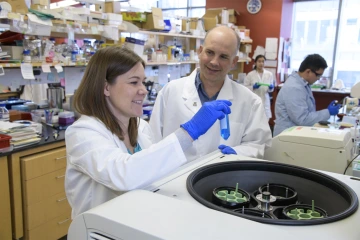You Should Definitely Get a Flu Shot This Year – Here’s Why
The convergence of the flu season and the COVID-19 pandemic calls for vigilance with masks, handwashing, social distancing – and a flu shot.

If more people receive the flu shot this year, the burden on testing and hospital systems will be lighter. Photo by Heather Hazzan, used under creative commons license from Self Magazine.
Fall is on the way, which means flu season is almost here. With the ongoing presence of COVID-19, getting a flu shot is more important than ever. That might sound counterintuitive – after all, the flu shot doesn’t protect against COVID-19, for which a vaccine has yet to become available. But University of Arizona Health Sciences experts say a flu shot remains a crucial component of the disease-prevention toolkit, alongside masks, handwashing and social distancing.
Avoiding a flu and COVID-19 ‘twindemic’
With SARS-CoV-2, the virus that causes COVID-19, still in circulation and flu season upon us, there is concern over a “twindemic,” in which these two respiratory diseases converge to fuel a spike in demand for testing, hospital beds and respirators. To reduce the burden on the nation’s health systems, everyone age 6 months and older is urged to receive a flu shot this year.

Jun Wang, PhD, looks at cells infected with a virus to see if an antiviral drug candidate shows promise.
“We should do whatever we can to make sure hospitals are not overloaded,” said Jun Wang, PhD, associate professor at the College of Pharmacy, whose research interests include influenza viruses as well as the novel coronavirus. “If many people get sick at the same time, you’d expect more people would die because sick people cannot be taken care of in hospitals, and don’t get the treatment they need.”
Dr. Wang says SARS-CoV-2 represents something of a wildcard this flu season.
“If someone is infected by both flu virus and SARS-CoV-2, we do not know what the consequences would look like, but I can almost be certain it’s not going to look good,” Dr. Wang said. “Normally, a viral infection will cause inflammation and weaken the immune response, so there’s a fairly good chance that co-infection with these two viruses would lead to severe consequences. To prevent that, we should get the flu shot – at least this would minimize the complications of co-infection.”
Get a flu shot from the university to boost your immunity
Dr. Wang added that people should still wear masks, thoroughly wash their hands and practice social distancing to reduce risk of both infections, but vaccination is the greatest prevention of all. “While we are desperately waiting for a COVID-19 vaccine, we should get a flu shot to get at least one of the problems out of the equation,” he said.
University employees, as well as dependents age 4 and older, can obtain free flu shots through Life & Work Connections – though the process has changed from previous walk-up availability.
“We will be holding flu shot clinics on campus for those working on campus, and additional community clinics for those working remotely. Unlike past years, the vendor will be using a scheduling system for participants to schedule a time for an appointment,” said Chad Myler, MS, CHES, health promotion manager for Life & Work Connections. “We will require that participants wear a face covering and practice physical distancing, per university guidelines. Each of the clinics this year will be held outdoors to help mitigate the risk of spreading COVID-19 and the flu.”
How a vaccine educates the immune system
The flu shot teaches immune cells to recognize common flu viruses and attack them before they can do damage. These immune cells march through the bloodstream, on the lookout for invaders, and come in two types: innate and adaptive.
“The innate immune system is your first line of defense,” explained Michael Kuhns, PhD, associate professor of immunobiology at the College of Medicine – Tucson and member of the BIO5 Institute. “These cells are sentinels, and they’re always at the ready in the event that you have a cut or some other insult that allows a pathogen into your body.”

Michael Kuhns, PhD, heads a lab devoted to understanding T cells, which direct immune response to pathogens.
Innate immune cells are generalists – jacks of all trades that can offer immediate, but nonspecific, protection from pathogens. They include macrophages, eating machines that roam the bloodstream, attacking germs. They leave behind pieces of these invaders called “antigens.”
And this is where the adaptive immune system’s job begins.
“These cells adapt to the challenge,” Dr. Kuhns said. “They make fine-tuned antigen receptors that can target pathogens in a highly specific manner.”
Adaptive immune soldiers called B cells use the antigens left by macrophages as templates to design custom-made antibodies. The next time that bug attacks, the immune system recognizes its antigens and deploys those antibodies, which attach to the pathogens and flag them for destruction by T cells. The adaptive immune system performs its tasks under the supervision of “helper” T cells called CD4 cells.
“CD4 T cells are like the field generals of the immune system,” Dr. Kuhns said. “They direct B cells to go out and make antibodies, and they direct killer T cells to go out and kill.”
By providing a “sneak preview” of this season’s flu viruses, the flu shot will prepare the immune system to mount an immediate defense against influenza, dramatically reducing risk of illness and death.
It takes the immune system a couple of weeks to manufacture antibodies, which means someone might get sick before their immune system can bring the infection under control.
Vaccines give the immune system a sneak preview of a dangerous virus’s antigens, allowing it to create antibodies. That way, instead of waiting two weeks, it can spring into action the instant that virus is detected.
Worldwide, millions of people come down with the flu every season, and tens of thousands of those infected die as a result. While the flu vaccine is not 100% effective, it reduces risk of catching the flu, and can decrease the severity of symptoms if you do catch it — keeping more people out of overburdened hospitals. The Centers for Disease Control and Prevention recommends getting the flu shot before the end of October.
“It’s absolutely critical that as many people as possible get a flu shot,” Dr. Wang said. “For this flu season, let’s do our best — let’s get a flu shot.”
Campus flu shot clinics for employees and retirees kick off on Sept. 23 on campus and throughout the community. See Life & Work Connections’ Flu Shot Clinic webpage for more information, including flu clinic schedules and a link to schedule an appointment.
UArizona students can receive a flu shot at Campus Health.
Anyone can get the flu shot at drugstores, the health department or other clinics — a CDC tool can help find a nearby flu shot clinic. Health insurance plans cover the flu shot with zero or low copays. Without health insurance, out-of-pocket costs could be about $20 to $40.

